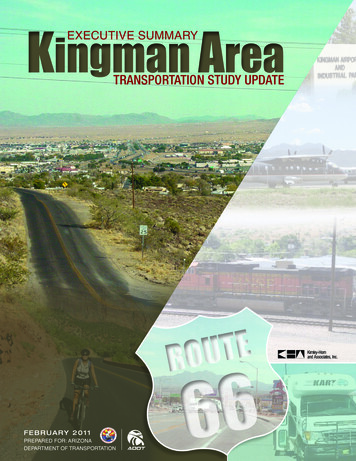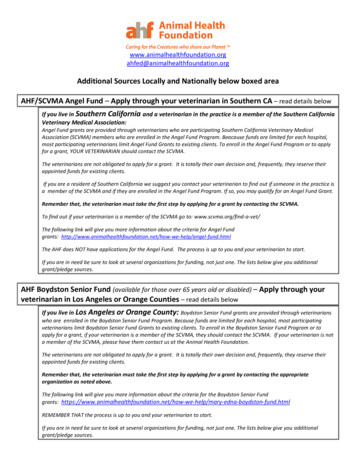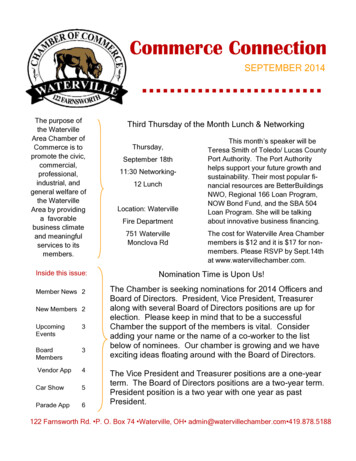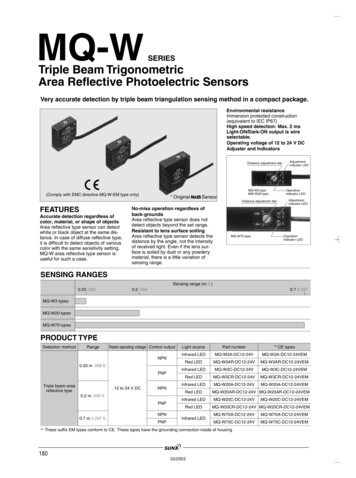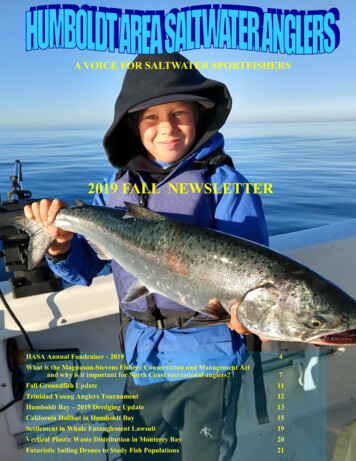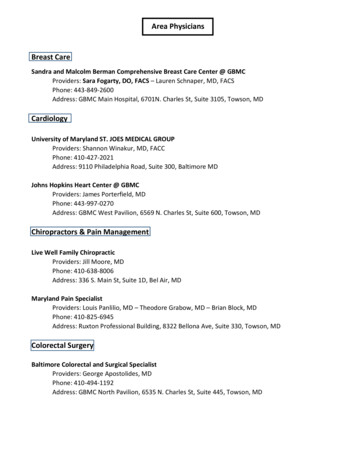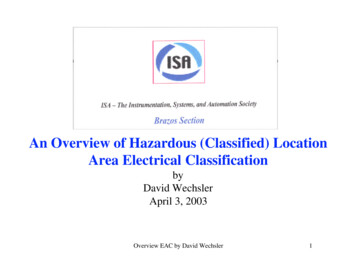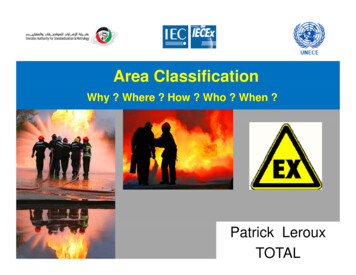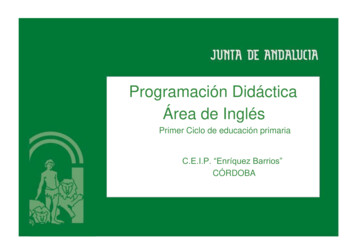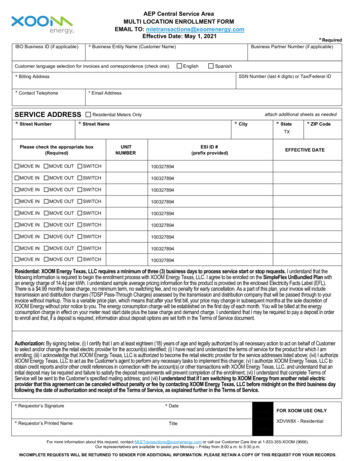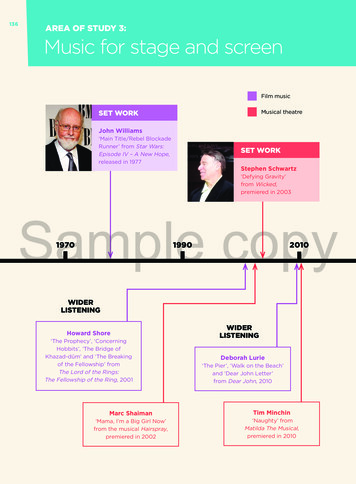
Transcription
136AREA OF STUDY 3:Music for stage and screenFilm musicSET WORKMusical theatreJohn Williams‘Main Title/Rebel BlockadeRunner’ from Star Wars:Episode IV – A New Hope,released in 1977SET WORKStephen Schwartz‘Defying Gravity’from Wicked,premiered in 2003Sample copy197019902010WIDERLISTENINGHoward Shore‘The Prophecy’, ‘ConcerningHobbits’, ‘The Bridge ofKhazad-dûm’ and ‘The Breakingof the Fellowship’ fromThe Lord of the Rings:The Fellowship of the Ring, 2001WIDERLISTENINGDeborah Lurie‘The Pier’, ‘Walk on the Beach’and ‘Dear John Letter’from Dear John, 2010Marc ShaimanTim Minchin‘Mama, I’m a Big Girl Now’from the musical Hairspray,premiered in 2002‘Naughty’ fromMatilda The Musical,premiered in 2010
AREA OF STUDY 3: MUSIC FOR STAGE AND SCREEN137This area of study is a varied topic, and the first set work comesfrom the genre of musical theatre. The modern musical developedin the early 20th century, but its roots go back much further to theparallel traditions of operetta and variety shows.Many of the earliest musicals, such as The Wizard of Oz (1902), included songs from a varietyof sources that might change from one production to another. However, Showboat (1927)introduced the idea of the book musical, in which songs, vocal ensembles and dances arefully integrated into a plot with serious dramatic goals.Some of the most famous and iconic musicals of the decades that followed, most of whichare still performed today, include:A nything Goes, music and lyrics byCole Porter (1934)O klahoma! music byRichard Rodgers (1943)K iss Me Kate, music and lyrics byCole Porter (1948)S weeney Todd: The Demon Barberof Fleet Street, music and lyrics byStephen Sondheim (1979)L es Misérables, music byClaude-Michel Schönberg (1980)T he Phantom of the Opera, music byAndrew Lloyd Webber (1986)Sample copyS outh Pacific, music byRichard Rodgers (1949)T he King and I, music byRichard Rodgers (1951)M y Fair Lady, music byFrederick Loewe (1956)W est Side Story, music byLeonard Bernstein (1957)T he Sound of Music, music byRichard Rodgers (1959)O liver!, music, book and lyrics byLionel Bart (1960)C abaret, music byJohn Kander (1966)J esus Christ Superstar, music byAndrew Lloyd Webber (1971)A Chorus Line, music byMarvin Hamlisch (1975)T he Lion King, music byElton John and others (1997)W icked, music byStephen Schwartz (2003)B illy Elliot the Musical, music byElton John (2005).T he Scottsboro Boys, music byJohn Kander (2010)M atilda the Musical, music byTim Minchin (2010)In recent decades, compilation musicalsor jukebox musicals written around theback-catalogue of a pop singer or popgroup have become popular. For example,We Will Rock You (2002) is a showcase forsome of the most famous songs by Queen.MUSICALS IN FOCUSFor more detail on the history and developmentof the musical, see Musicals in Focus by Paul Terry(Rhinegold Education, RHG 911).TIMELINE & MUSICAL THEATRE: INTRODUCTIONMusical Theatre
DEFYING GRAVITY138GCSE MUSIC STUDY GUIDESet work 1:‘Defying Gravity’from Wickedby Stephen SchwartzWicked is one of the most successfulmusicals of modern times. The music andlyrics are by Stephen Schwartz (born 1948),whose many credits include the musicalGodspell (1971) and the lyrics for Disney’sanimated musical film Pocahontas (1995).ContextWicked the musical is based on the 1995fantasy novel Wicked: The Life and Times ofthe Wicked Witch of the West by Americanauthor Gregory Maguire.Sample copyAimed at adults, rather than children, the novel creates aback-story for many of the characters in L. Frank Baum’s classicchildren’s novel The Wonderful Wizard of Oz and the 1939musical film The Wizard of Oz.It explores the nature of good and evil, and offers a newperspective on the characters and events in the original story(a process known as literary revisionism). In particular, thecharacter Elphaba, known to generations as the Wicked Witch ofthe West in The Wizard Of Oz, is portrayed in the musical Wickedas a sympathetic character who is treated badly for being true toher beliefs.Wicked was first performed in San Francisco, in June 2003, andlater that same year transferred to Broadway (New York’s theatredistrict). It opened in London’s West End in 2006, and in 2016 itbecame the eighth-longest-running show in the West End.The 1939 musical film The Wizard of Oz (which, along with theoriginal novel, was the inspiration for Wicked) starred the 16-yearold Judy Garland as Dorothy and includes the songs ‘We’re Off ToSee the Wizard’, ‘Ding-Dong! The Witch is Dead’ and ‘SomewhereOver the Rainbow’.
AREA OF STUDY 3: MUSIC FOR STAGE AND SCREEN139DEFYING GRAVITYSample copyWicked opened at the ApolloTheatre in London in 2006, and in2016 became the eighth-longestrunning show in the West EndSynopsis of Wicked the musicalThe musical begins with the death of Elphaba,the Wicked Witch of the West.Through flashback, we learn from Glinda (the Good Witch of theNorth) that the two girls were at university together, where thebeautiful, popular and spoilt Glinda initially loathed the greenskinned Elphaba, who had been misunderstood and shunned bysociety.Having shown a talent for sorcery, the two girls were sent to helpthe Wizard of Oz, who Elphaba discovers to be a corrupt dictator,busy suppressing the minority group of sentient animals in Ozby caging them and segregating them to prevent them learninghow to speak. Elphaba realises that the wizard is a charlatan whopossesses no magic powers, and she vows to fight his injustices.Fearful of Elphaba’s own magic powers, the wizard denounces heras wicked and uses propaganda to turn the people of Oz againsther. A hunt begins and Elphaba is forced into hiding. She seeksasylum in Munchkinland but her request is refused by its governor(her cruel and embittered sister, who has become known as theWicked Witch of the East).
DEFYING GRAVITY140GCSE MUSIC STUDY GUIDEDuring the show we discover that the Scarecrow and Tin Manwere once boyfriends of the witches, transformed by their spells,a lion cub freed from experiments by Elphaba grows up to be theCowardly Lion and the Wizard of Oz turns out to be Elphaba’sfather. Glinda has come to respect Elphaba’s strength in standingup for what is right, and laments the loss after Dorothy appears tohave killed her – but just before the end of the musical, we learnthat Elphaba survived and is still alive.Defying GravityThe individual musical items in a musical(e.g. songs, choruses and dances) are knownas numbers. ‘Defying Gravity’ is No. 17 inWicked and forms the finale to Act One –a cliff-hanger moment designed to leave theaudience wanting to know more.Here, Elphaba, who had long dreamed of working with the Wizardof Oz, has discovered that he is behind the mistreatment ofanimals. He has been using her to provide the magic powers hehimself lacks. She changes her opinion of the wizard, and resolvesto take a stand against him. He threatens to kill the girls ratherthan be unmasked. They in turn barricade themselves into thehighest tower in the wizard’s castle.Sample copyElphaba levitates a broomstick to escape and, as the castle guardhammers on the door, she tries in vain to convince Glinda to joinher. The guards burst in and Glinda wishes her well as Elphabarises into the sky on her broomstick, promising to fight the wizardwith all her power. Meanwhile the citizens of Oz rush in to end theact with cries of ‘Get her! We’ve got to bring her down.’ResourcesThe limited time available between finalisingthe key and structure of songs in rehearsalsfor a musical and the date of the openingmeans that musicals are often orchestrated bya specialist rather than by the composer.In the case of Wicked, that was Bill Brohn, who also orchestratedthe scores of Miss Saigon and many other musicals.Wicked is scored for a band of 23 musicians: Four strings (two violins, viola, cello) Double bass (doubling fretted and fretless bass guitars) Four reeds (i.e. woodwind players)Six brass (two each of trumpets, trombones and horns)George Maguire’sname for the WickedWitch of the West,Elphaba, derives fromthe pronunciation ofL. Frank Baum’s initials(L–F–B).
AREA OF STUDY 3: MUSIC FOR STAGE AND SCREEN Drums Percussion Three keyboards.In this context,doubling meansplaying more than oneinstrument during thecourse of the work.The limited room in orchestra pits means that the reed playershave to double on a number of instruments – particularly thefourth player who has to switch between flute, clarinet, bassclarinet, bassoon and baritone saxophone. Similarly, there isseldom room for a full string section, so here the solo strings arebolstered by string sounds from the keyboard players. However,a full body of strings would normally be used for recordings.The excerpt in the anthology is in the form of a short score whichshows the main band parts on just two staves. A pianist can playfrom this to accompany rehearsals.Points to note in the orchestration of ‘Defying Gravity’ include: lectric guitar with overdrive (a type of distortion) in bars 11,E40 and 45 hordal writing for low brass contrasting with melody on soloCsynth (bars 20–23)Sample copy String tremolo (markedand 162–165)A glockenspiel hashigh-pitched metalbars played withbeaters.) to create excitement (bars 34–36 rum fill (bar 54) – a brief drum improvisation to fill the gapDbetween vocal phrases Descending scales for bass clarinet (bars 89 and 91) Cymbal roll to announce the change of key (bar 122) Tutti (full band) for the climax at bar 135 ynth and glockenspiel (see left) play a high-pitched ostinatoSas Elphaba sings of flying high (bars 152–160).The two principal singers, Elphaba and Glinda, require the vocalranges shown left for this number. A mezzo soprano is a voicelower in range than a soprano.StructureSCENAIn music theatre, ascena (Italian for scene)is a continuous piece ofvocal music comprisingseveral distinctsections.The core of ‘Defying Gravity’ is a song in verse-and-chorus formfor Elphaba. The music is also used to create an impressive finalefor Act One. This is expanded into: A scena with duet sections Passages of underscore (music played under dialogue) ecitative (vocal music that follows the rhythms of naturalRspeech) t the very end, the entry of the chorus and some veryAimpressive stage effects just before the curtain falls.DEFYING GRAVITYTwo guitars and harp141
DEFYING GRAVITY142GCSE MUSIC STUDY GUIDETimeBarSection0:0411:17342Verse 1 (Elphaba): ‘Something has changed within me ’1:51502Chorus (Elphaba): ‘It’s time to try defying gravity ’(Glinda sings the link at bar 60)2:10632Verse 2 (Elphaba): ‘I’m through accepting limits ’2:35792Chorus (Elphaba): ‘I’d sooner try defying gravity ’(Glinda sings the link at bar 60)2:4888Bridge (Elphaba): ‘Unlimited, together we’re unlimited.’( Glinda from bar 100)Intro (recitative between Glinda and Elphaba): ‘I hope you’re happy ’Sample copy3:271023Chorus (Elphaba and Glinda): ‘Just you and I defying gravity ’(orchestral build at end )3:531152Varied reprise of intro (Glinda, then both): ‘I hope you’re happy ’4:321352Verse 3 (Elphaba): ‘So if you care to find me’(some parts 8ve higher than before)4:581512Chorus (Elphaba): ‘Tell them how I am defying gravity ’5:151614Coda (Elphaba, then all): ‘And nobody in all of Oz ’As with many excerpts from musicals, published versions often differfrom the stage show because some of the complete text may makelittle sense without the visual aspects of the production. The versionon the anthology CD is from the original cast recording, which omitsfurther passages of underscore in bars 20–21 (where, following a rollof thunder, Elphaba is falsely denounced as an enemy of the people),90–92 (where she begins to chant a flying spell as guards try to breakdown the door) and, more briefly, in bars 113–114. Note that the scorein the anthology is a semitone higher than the recording.LeitmotifsA leitmotif (German for ‘leading motif’) is a short musical ideathat a composer links to a particular person, place, object oremotion in a music drama.The concept is particularly associated with the operas of the 19thcentury German composer, Richard Wagner. He developed andcombined motifs, transforming them to suggest to the audience the
AREA OF STUDY 3: MUSIC FOR STAGE AND SCREEN143Leitmotifs have been used in film music by composers such asJohn Williams and they also appear in musicals such as Wicked.Here, leitmotifs are used to help unify the work and as a simplereminder of things witnessed earlier, rather like musical labels(although they are rarely woven into the fabric of the musicand developed in the symphonic way preferred by Wagner).For example, when Glinda reassures Elphaba that she can stillbe with the wizard (bars 234–252) she quotes (a 4th higher) themotif sung by Elphaba in ‘The Wizard and I’, near the start of theshow, when Elphaba was dreaming of meeting the wizard:Sample copyStephen Schwartzsaid that he based the‘Unlimited’ leitmotifon ‘Over the Rainbow’in homage to itscomposer, HaroldArlen. He added, onlyhalf jokingly, that hekept the quotation toseven notes to avoidinfringing copyright.In fact, because therhythm and harmonyare totally different,many people don’tspot the quotation.The leitmotif shown in examples b and c below permeatesWicked and has an unusual derivation because it is actually thefirst seven pitches of ‘Over the Rainbow’, the most famous songin the 1939 musical The Wizard Of Oz – shown as a. below.All of the quotations below are printed in the same key for easeof comparison. The pitches of a. are used in ‘The Wizard and I’, asshown on stave b., causing it to become known as the ‘Unlimited’leitmotif from the text at this point. Stave c. shows how Schwartzused it in bars 93–4 of ‘Defying Gravity’ and stave d. shows howhe adapted it, adding the two notes shown in red, to form the tinysynthesiser flourishes in bars 21, 23 and 33:DEFYING GRAVITYemotions and motivation of the characters on stage withoutnecessarily having to use words.
DEFYING GRAVITY144GCSE MUS
‘Mama, I’m a Big Girl Now’ from the musical Hairspray, premiered in 2002 Tim Minchin ‘Naughty’ from Matilda The Musical, premiered in 2010 1990 John Williams ‘Main Title/Rebel Blockade Runner’ from Star Wars: Episode IV – A New Hope, released in 1977 SET WORK Stephen Schwartz ‘Defying Gravity’ from Wicked, premiered in 2003
